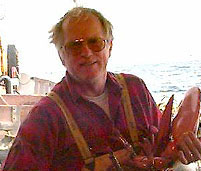
Professor of Biology, University of Massachusetts
Email: joe@bio.umass.edu
J. Kunkel Biology Dept Website
Ph.D.: Case Western Reserve University
Postdoctoral Training: Case Western Reserve University; Yale University; University of California at Berkeley; University of Berne, Switzerland; Marine Biological Laboratories, Woods Hole, Mass.
Pattern Formation and Development
Changing patterns of morphological structure, appearance of new macromolecular entities, and patterns of localization of macromolecules are hallmarks of the developmental process. In my lab, the expression pattern, structure, and function of storage proteins during animal development is a major focus. The abundance and large size of storage proteins make them attractive models for studying cellular localization phenomena. Many storage proteins are synthesized in one tissue, secreted into circulation and subsequently taken up by another tissue for utilization. Several of these proteins have homologues throughout the animal kingdom and the evolution of their structure and regulation interests us.
We have begun a study of natural variation in amounts of stored proteins in eggs and serum of economically important animals. One species, the gypsy moth, Lymantria dispar (Lepidoptera), causes substantial deforestation in North America. Heterogeneity of stored reserves in the egg may be an overwintering strategy for survival in this species. In winter flounder, Pleuronectes americanus, embryonic utilization of egg proteins may provide a means to monitor normal and abnormal development during early embryogenesis in this bottom feeding organism which lives in the estuaries adjacent to sources of pollution. In Atlantic cod, Gadus morhua, we are examining the alarming trend toward early maturation that is evident in our local population on Georges Bank. We also explore the cellular basis of pattern formation in oocytes of the cockroaches Blattella germanica and Periplaneta americana and the amphibian Xenopus laevis with our studies of ion flux during early development. The evolutionary consequences of pattern regulation are being studied in relation to tetrapod body plan and insect wing venation. Neutral aspects of wing venation are being used to measure phylogenetic and population differences among insects.
Representative publications:
Franklin-Tong, V. E., T. L. Holdaway-Clarke, K. R. Straatman, J. G. Kunkel and P. K. Hepler (2002). "Involvement of extracellular calcium influx in the self-incompatibility response of Papaver rhoeas." Plant J 29(3): 333-345.
Feijó, J. A., J. Sainhas, T. Holdaway-Clarke, M. S. Cordeiro, J. G. Kunkel and P. K. Hepler (2001). "Cellular oscillations and the regulation of growth: the pollen tube paradigm." Bioessays 23(1): 86-94.
Faszewski, E. E. and J. G. Kunkel (2001). "Covariance of ion flux measurements allows new interpretation of Xenopus laevis oocyte physiology." J Exp Zool 290(6): 652-61.
Cardenas, L., T. L. Holdaway-Clarke, F. Sanchez, C. Quinto, J. A. Feijó, J. G. Kunkel
and P. K. Hepler (2000). "Ion changes in legume root hairs responding to Nod factors." Plant Physiol 123(2): 443-52.
Feijó, J.A., Saínhas, J., Hackett, G.R., Kunkel, J.G. and Hepler, P.K. (1999) Growing pollen tubes possess a constitutive alkaline band in the clear zone and a growth-dependent acidic tip. J. Cell Biol. 144(3), 483-496.
Roy, S.J., Holdaway-Clarke, T.L., Hackett, G.R., Kunkel, J.G., Lord, E.M. and Hepler, P.K. (1999) Uncoupling secretion and tip growth in lily pollen tubes: evidence for the role of calcium in exocytosis. Plant J. 19, 379-386.
Cardenas, L., Feijó, J.A., Kunkel, J.G., Sanchez, F., Holdaway-Clarke, T., Hepler, P.K. and Quinto, C. (1999) Rhizobium nod factors induce increases in intracellular free calcium and extracellular calcium influxes in bean root hairs. Plant J. 19, 347-352.
Hartling, R.C. and Kunkel, J.G. (1999) Developmental fate of the yolk protein lipovitellin in embryos and larvae of winter flounder, Pleuronectes americanus. .
Hartling, R.C., Pereira, J.J. and Kunkel, J.G. (1997) Characterization of a heat-stable fraction of lipovitellin and development of an immunoassay for vitellogenin and yolk protein in winter flounder (Pleuronectes americanus). J. Exp. Zool. 278, 156-166.